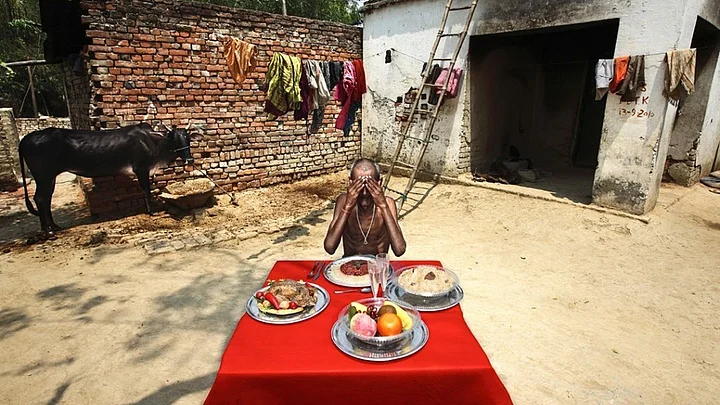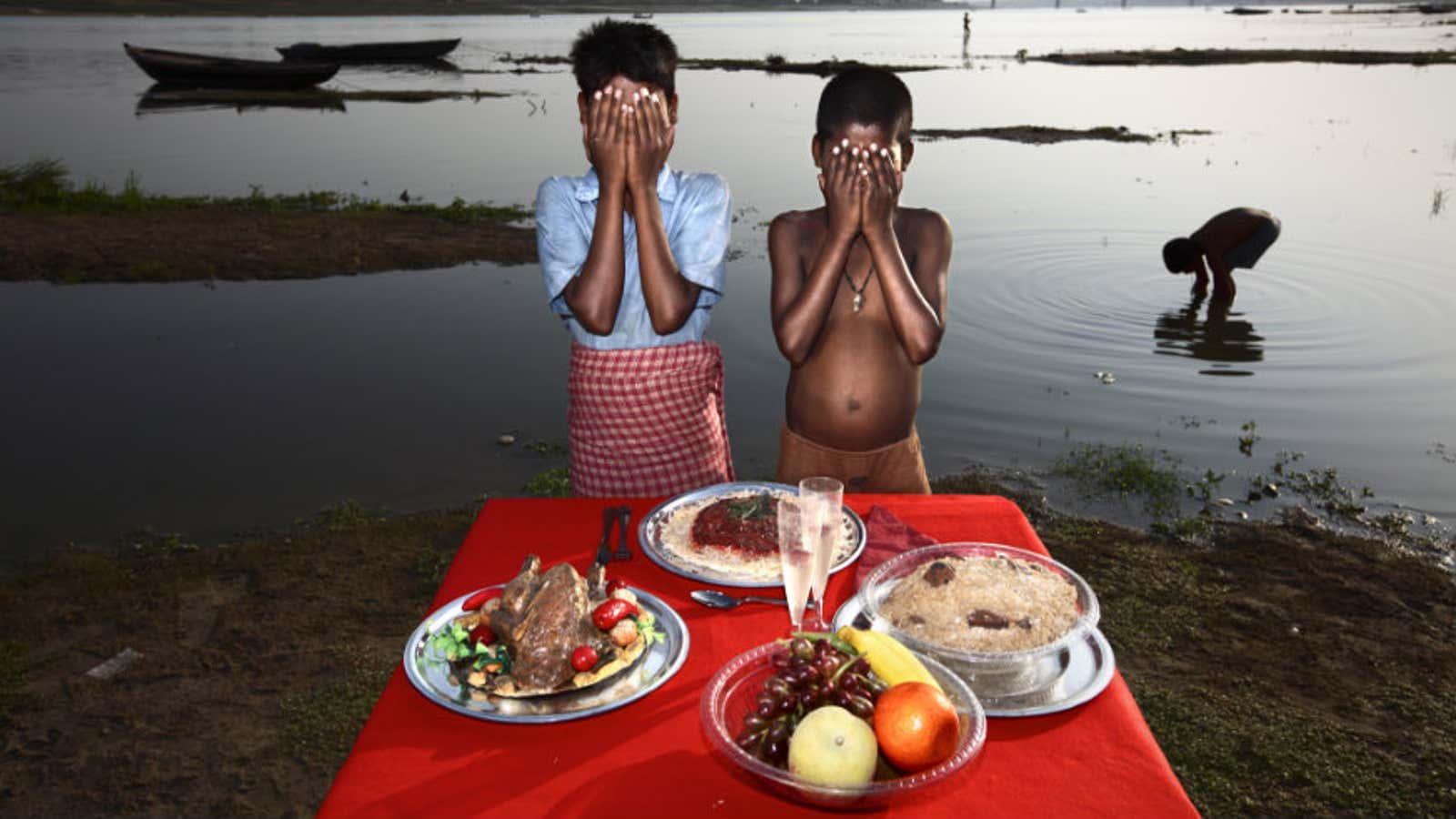Ethics of Photojournalism
After getting to know those villagers he spoke to, Mamo explained to them the idea behind his project. It required volunteers, of which Mamo found among the people he had just established friendly relations with. The set was prepared, with the villagers who had agreed to be volunteers excited to be photographed and participate in such a project.
On July 22nd of 2018, five of the photos in Mamo's project, titled "Dreaming Food", were posted to the World Press Photo Instagram account.
The backlash was immediate.
But what even was "Dreaming Food" in the first place?
According to Mamo himself in his statement about his project after-the-fact, he "...was obsessed by the food thrown away especially in Christmas time... The idea was to create a contrast between a typical Western table with luxurious food in a poor context that could emphasize this contrast."
How he went about highlighting this contrast was to set up a table with fake food on it, and position his volunteers from the Indian villages in front of the table, covering their faces while imagining the food they wanted to see (hence the title "Dreaming Food).
 |
| Photo by Alessio Mamo, 2011 |
Mamo's stated intention with this setup was "...to let western people think, in a provocative way, about the waste of food." It is easy to see how his thought process translated into these images, even if it is rather heavy-handed.
 |
| Photo by Alessio Mamo, 2011 |
Regardless of good intention or not, the nature of the backlash against Mamo's project boils down to the exploitation of the subjects and a lack of understanding of the issue he is presenting.
From a photographic angle, the exploitation criticism is that the way the photographs are composed demeans the subjects. They were instructed to cover their faces, which is one of the main physical features people use to recognize other people as human beings. They are also people living in poverty, but sit in front of a fake spread of lavish food. Just as the symbolism writes itself, so does the insensitivity. Sutirtha Chatterjee, who is an Indian documentary photographer, put it like this in a quote from an article on Quartz regarding the controversy: "The photographs... have attempted to draw a comparison
between the food waste in the West and the crisis in our country. In
doing so, it has translated the statistics into visuals, without any
regard for the intrinsic human values of the people photographed. They
are stripped off their agency and dignity and reduced to mere props to
visualise these stats." Chatteriee also alludes to another problem that makes the photographs appear exploitative and also leads into the lack of understanding of the issue presented.
What IS the causal link between food waste in the West and the hunger crisis in India? Will not wasting food actually help alleviate the crisis? Maybe. But the point is the link is not intuitive enough when the photographs are implying such a connection. The focus is on making Western people feel bad about wasting food instead of engaging with the reasons behind where there is a hunger crisis in India in the first place, instead using Indian citizens as props for a general cause.
In relation to my personal ethics, it's important to keep in mind that my personal ethics are largely based on what would generally be understood as ethical in science. For example, it's ethical to obtain consent from the research subjects before performing the experiment on them, it's ethical to give them a debrief after the fact for full transparency, etc.
 |
| Photo by Madeline Jacyszn, 11/13/23, a set of four Russian nesting dolls with "equity", "empathy", "consent", and "transparency" written on them |
Going off of Mamo's personal statement on his project, it does appear that he explained his project to them and thus obtained informed consent from them. Under my personal ethics, that would be considered ethical. However, it isn't quite so cut-and-dry. As this article from photoethics.com about the controversy points out, "...[Mamo] does not make it clear that [the subjects] understood that participating does not impact their relationship with the aid organization. It is also unclear whether he explained where the images will be viewed, how they will be presented, or how he might profit from them." It goes on to explain that even if he did explain this, they might lack the context to understand the full implications of what they're agreeing to because they might not have internet access and therefore the context of how far those images can spread.
Regarding empathy, I don't think it meets the qualifications to be considered empathetic under my personal code of ethics. Whether intended or not, certain choices in the photographs distance the viewer from the subjects, such as the instruction for them to cover their face. It impedes the human connection from viewer to subject because the face is one of the main visual features people use to view another person as "human". There is also the angle that putting fake food in front of people living in poverty is inevitably going to be seen as in poor taste. It comes off as at worst a taunt or at best tone-deaf to their situation.
With equity, I also don't think this project was very fair to either its Western audience or the Indian people. For one, the stated goal of the project by Mamo himself is to make Westerners become more conscious about food waste. But the composition of the project doesn't take into account other major factors like food distribution which would arguably have as much if not a greater impact. It also uses Indians as props to make this point, without establishing a causal link that would help this project land with more impact. If people understand more tangibly how them not wasting food would actually help people in poverty, that would be a stronger call to action for them. But also it doesn't consider the specifics of the hunger crisis in India, or draw attention to what exactly is causing it.
Which is what I think the main struggle of the project is. It needs to pick one. Personally, if I did this project, I would focus on highlighting the hunger crisis in India and the different elements to it. It's a struggle that puts the focus on the Indian people themselves instead of the Western audience and draws attention to their situation instead of just using them as props for a tangentially related agenda. If I was to keep the premise of making Western people reconsider food waste, I would change the subject completely and keep it in the West, focusing instead on something like massive dumpsters overflowing with food or something of the like. It would show more tangibly with a stronger link where all the food waste is going and promote that the food should not be wasted.

Comments
Post a Comment